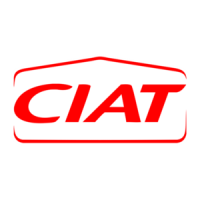3
1 IMPORTANT RECOMMENDATIONS
Your unit is equipped with a microprocessor-controlled electronic circuit board. To ensure the correct operation of your machine,
you must follow the rules listed below.
Electrical power supply
Remote control: 230 V AC/50 Hz.
If the machine‟s remote control is powered separately
(transformer not supplied), provide the following:
1 - A power supply line running directly from a distribution point
(this line must be used only to supply power to the machine‟s
remote control).
2 - This power supply line must be at least 1 metre away from all
power lines (400 V).
Specifications of the CONNECT 2 board
Board power input: 35 Watts.
Maximum allowable voltage and current per input/output:
253 V AC -3.15 A.
The board is powered by an onboard screw-on three-pin
connector. The terminals are identified as follows:
1 - Live,
2 - Neutral,
3 - Earth.
Board fuse specifications:
Schurter UMT 250 V AC/3.15 A. Time lag: 10 × 3.
Product code: 34031 0171.
Environmental conditions:
- In storage → -40/+80°C, 5/85% humidity without condensation.
- In use → -20/+70°C, 5/85% humidity without condensation.
Degree of pollution: 3.
Warning
Read the instructions in the manual before attempting to service
the product.
Before attempting to service the board, disconnect its power
source and make sure that no voltage is present.
To prevent the risk of electric shock, access to the board
should be impossible while it is energised.
Certain parts of the board (USB and Ethernet connectors) may be
hot. Based on the ambient temperature, they could cause burns.
As a result, avoid touching these connectors while they are
connected.
Warning:
There is a risk of explosion if the battery is replaced by an
incorrect type.
Dispose of used batteries in accordance with local regulations.
Earthing
Compulsory (good earth quality in compliance with French
standard NF C 15-100).
Connection of sensors
Keep connection cables away from power lines (400 V) or a
remote control line (230 V). In the case of distances of over 6 m,
use a shielded cable connected to the earth on the unit.
Maximum distance: 25 m.
Connection of communication buses and of
the remote console
4-1 Connection cable specifications
- Flexible cable – RS 485 connection
- Two shielded wires
- Capacitance between cables and shield: 120 pF/m
- Resistance: 56 Ω/km
4-2 Connection of the shield
- Connect the shield on the BMS or micro-computer end to earth.
- Ensure bonding all the way to the last unit
(the shield on the communication cable must be
connected between each unit).
- Do not connect the shield to the earth connection on the units.
- The wires exiting the shield must be as short as possible (2 cm)
on each unit.
4-3 Cable routing
- The cable must be at least 30 cm away from all 230 V or 400 V
cables along its entire length.
- If a 230 V or 400 V cable must be crossed with a computer
cable, they must cross each other at a right angle.
Connection of on/off inputs
Distances of less than 30 metres:
- Use a shielded cable. Keep the cable at least 30 cm away from
all lines that could generate interference. Connect the shield to
the earth on the unit. If several shielded cables are used, connect
each shield separately (if the risk of interference persists, install a
relay for each input).
Distances of greater than 30 metres:
- Install a relay for each input near the electronic circuit board
(cable cross-section: 0.5 mm
2
)
Example connection diagram:
K: Auxiliary relay (fit near the electronic circuit board)
CA: Automatic operation control (on each machine)
2 GENERAL
The CONNECT 2 control module is fitted as standard on water chillers (or water heaters) equipped one or two refrigerating circuits and scroll
compressors. It is fitted on water-to-water, air-to-water and reversible air-to-water units.
Depending on the configuration, the board provides the following functions:
► Control of chilled water or hot water temperatures.
► Continuous monitoring of operating parameters.
► Diagnostics and fault storage.
► Setpoint drift based on the outdoor temperature (in heating and cooling modes).
► Communication with the console (remote or local) and the additional boards (fault reporting, BMS communication, Ethernet link for PC).

